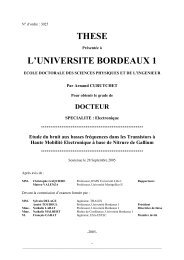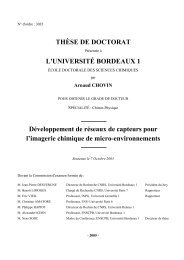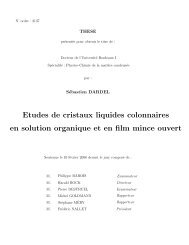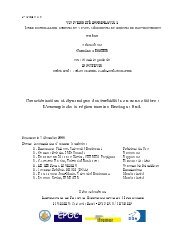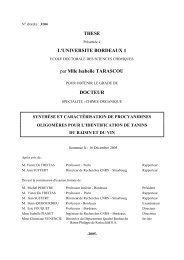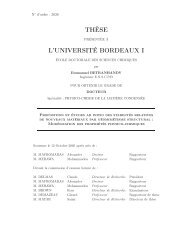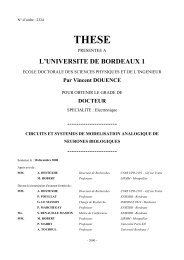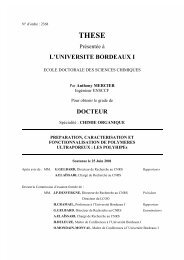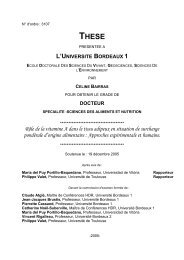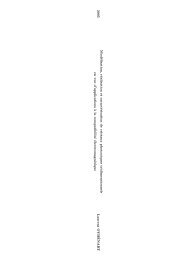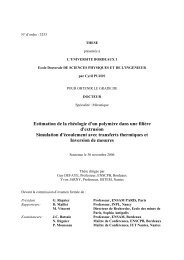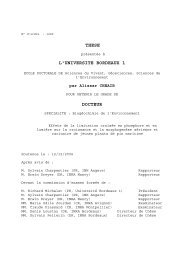THÃSE DE DOCTORAT EN COTUTELLE - Université Bordeaux 1
THÃSE DE DOCTORAT EN COTUTELLE - Université Bordeaux 1
THÃSE DE DOCTORAT EN COTUTELLE - Université Bordeaux 1
- No tags were found...
You also want an ePaper? Increase the reach of your titles
YUMPU automatically turns print PDFs into web optimized ePapers that Google loves.
Evaluation non destructive du béton par mesures de résistivité électrique et thermographie infrarouge passiveRésuméDans les pays industrialisés, les ouvrages en béton vieillissent. Les gouvernements mettent alors en place des politiques de gestiondu patrimoine, et l’évaluation de l’état d’endommagement de ces structures devient une donnée essentielle à la planification destravaux. Dans cette problématique, l’Evaluation Non Destructive apparaît comme étant un outil adapté au contexte et aux besoinsdes maîtres d’ouvrages.Parmi les méthodes existantes, la mesure de résistivité électrique présente une sensibilité à la porosité du matériau, et à la circulationdes charges électrolytiques dans la matrice, qui peut être exploitée pour l’étude des altérations du béton. La mesure parthermographie infrarouge passive est également sensible à la porosité du matériau et à ses conditions hydriques. Cette sensibilitépeut être utilisée pour le diagnostic des altérations des ouvrages en béton.Les travaux effectués au cours de la thèse ont pour objectif d’étudier et de développer les deux techniques afin de caractériser l’étatdes ouvrages en béton.Dans un premier temps, le travail s’oriente sur la définition d’une procédure de mesure in situ qui prend en compte les différentesgrandeurs d’influence de la mesure afin d’en minimiser les effets ou d’acquérir l’information nécessaire à leur correction en phase dedépouillement. Dans un second temps, l’étude de la capacité des deux méthodes à caractériser l’état du béton est réalisée.Des mesures sur corps d’épreuve en béton permettent d’étudier la sensibilité des deux techniques à la présence d’ions chlorures, àl’ajout de cendres volantes, de fumées de silice ou encore de fibres de différentes natures. Des travaux de modélisation numérique(en électrique) montrent l’influence de l’épaisseur de l’élément ausculté, d’une couche superficielle conductrice (couche saturée, parexemple) et résistante (couche carbonatée, par exemple). Des études plus spécifiques finissent d’élargir le champ des possibilitésd’utilisation des deux techniques en génie civil, avec notamment l’étude des conditions hydriques dans le béton et l’adaptation de laloi d’Archie, le diagnostic de l’endommagement crée par la réaction alcalis-granulats avec la définition d’indicateursd’endommagement ou encore la caractérisation de la fissuration et de la délamination.Le travail réalisé, à la fois en laboratoire et in situ, met en évidence la nécessité de maîtriser la mesure afin d’estimer correctement sareprésentativité. La définition d’un protocole de mise en œuvre des techniques, du traitement des données et de l’interprétation desrésultats propre à chaque problématique, contribue à définir des indicateurs d’endommagement du béton.Mots clésEvaluation Non Destructive, béton, résistivité électrique, thermographie infrarouge passive, conditions hydriques, Réaction Alcalis-Granulats, délamination.*************Non destructive evaluation of concrete by electrical resistivity measurements and passive infraredthermographyAbstractIn the industrialized countries, the concrete are ageing. The governments then set up management’s policies of the patrimony, andthe damage evaluation of these structures becomes an essential data with the planning of work. In this framework, the NonDestructive Evaluation seems being an adapted tool in the context and the needs for the building owners.Among the existing methods, the measurement of electrical resistivity is sensitive to material porosity, and the electrolyticcirculation in the matrix, which can be exploited for the study of deteriorations of the concrete. The measurement by passiveinfrared thermography is also sensitive to the material porosity and its hydrous conditions. This sensitivity can be used for thediagnosis of deteriorations of the concrete works.The works carried out during this thesis are to study and develop these two techniques in order to characterize the state of theconcrete structures.In a first step, work is directed towards the definition of a procedure of in-situ measurement which takes into account the variousactuating quantities of measurement in order to minimize the effects of them or to acquire information necessary to theircorrection in state of examination. In a second step, the study of the capacity of the two methods to characterize the state of theconcrete is carried out.Measurements on concrete test specimen allow to study the sensitivity of the two techniques due to the presence of ions chlorides,the addition of fly-ashes, of silica fume or of different types of fibers. Numerical electrical modelling shows the influence of thethickness of the inspected element, of a conducting surface layer (saturated layer) and of a resistant surface layer (carbonated layer).More specific studies enhance the field of the capacity of the two techniques in civil engineering, particularly the study of thehydrous conditions in the concrete and the adaptation of the Archie’s law, the diagnosis of the damage created by the alkaliaggregatesreaction with the definition of damage indicators or the characterization of cracking and the delamination.This study, in laboratory as in-situ, highlights the need for controlling measurement in order to estimate correctly itsrepresentativeness. The definition of a protocol of implementation of the techniques, data processing and specific interpretation ofthe results to each problem, contributes to assess concrete damage indicators.KeywordsNon Destructive Evaluation, concrete, electrical resistivity, passive infrared thermography, hydrous conditions, Alkali-AggregatesReaction, délamination.



